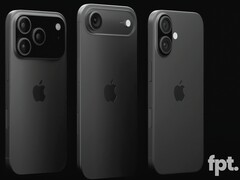Apple's Ultra-Thin iPhone Air Could Replace the Plus Model in 2025
Apple appears to be taking a dramatic new direction with its iPhone lineup, if the latest rumors prove accurate. According to a report from Front Page Tech, the company is developing an incredibly slim smartphone called the iPhone Air that would measure just 5.5mm thick—making it Apple's thinnest phone ever created. To put that in perspective, that's roughly half the thickness of current iPhone models and thinner than most credit cards stacked together.
The iPhone Air would reportedly replace the iPhone 17 Plus in next year's lineup, suggesting Apple may be rethinking its approach to larger smartphones. Rather than simply offering a bigger version of the base model, the company seems interested in creating something that stands out through sheer engineering audacity. The device would maintain a generous 6.6-inch OLED display, but with a significant upgrade: a 120Hz refresh rate that would finally bring ProMotion technology to non-Pro iPhones.

Creating such an impossibly thin device requires significant compromises, and Apple appears willing to make some bold choices. The most notable sacrifice would be camera versatility—the iPhone Air would feature only a single 48-megapixel rear camera. Instead of multiple lenses, Apple would rely on computational photography and digital cropping to simulate the functionality of telephoto and ultra-wide cameras. It's a fascinating bet on software over hardware, assuming that most users would accept slightly reduced camera flexibility in exchange for a device that feels revolutionary in hand.
The internal engineering challenges are equally intriguing. Fitting modern smartphone components into a 5.5mm frame requires rethinking nearly every aspect of phone design. Apple reportedly plans to use a higher-density silicon anode battery to maximize capacity within the constrained space. The company is also developing its own cellular modem, branded as the C1, which should consume less power than current solutions. Combined with the efficiency improvements expected from the new A19 chip, these changes aim to maintain acceptable battery life despite the physical limitations.
Performance shouldn't be a concern, as the iPhone Air would pack 12GB of RAM—a significant upgrade from current base models and enough to handle Apple's growing suite of AI features. While it won't get the Pro-level A19 chip, the standard A19 should provide plenty of power for typical users while supporting the on-device processing requirements of Apple Intelligence.
The positioning strategy reveals Apple's broader thinking about market segmentation. Rather than competing purely on features or screen size, the iPhone Air would target users who see their phone as a fashion statement and status symbol. The pricing would slot between the base iPhone 17 and iPhone 17 Pro, roughly where the Plus model currently sits, making it accessible to mainstream buyers who want something genuinely different.
This approach reflects a mature smartphone market where incremental improvements no longer generate the excitement they once did. By creating a device that's immediately recognizable as something new—you'd notice an iPhone Air's thinness from across a room—Apple could recapture some of the wonder that made early iPhones feel magical.
A Glimpse of Apple's Future Strategy
If the iPhone Air succeeds, it could signal a broader shift in Apple's hardware philosophy toward simplified, design-focused products that prioritize visual impact over feature complexity. The company has experimented with ultra-thin devices before, most notably with the original MacBook Air, which eventually influenced the entire laptop industry despite initial compromises in performance and connectivity.
Of course, all of this remains firmly in rumor territory. Apple hasn't confirmed any details about next year's iPhone lineup, and the company's plans could change significantly before any official announcement. The challenges of manufacturing such a thin device at scale, ensuring durability, and maintaining the user experience Apple customers expect are substantial.
Still, the concept feels distinctly Apple-like in its willingness to make bold tradeoffs in service of a compelling user experience. Whether consumers will embrace a single-camera iPhone in exchange for unprecedented thinness remains to be seen, but it would certainly give Apple something genuinely new to talk about in an increasingly crowded smartphone market. If nothing else, the iPhone Air represents the kind of ambitious thinking that has historically set Apple apart from its competitors.
